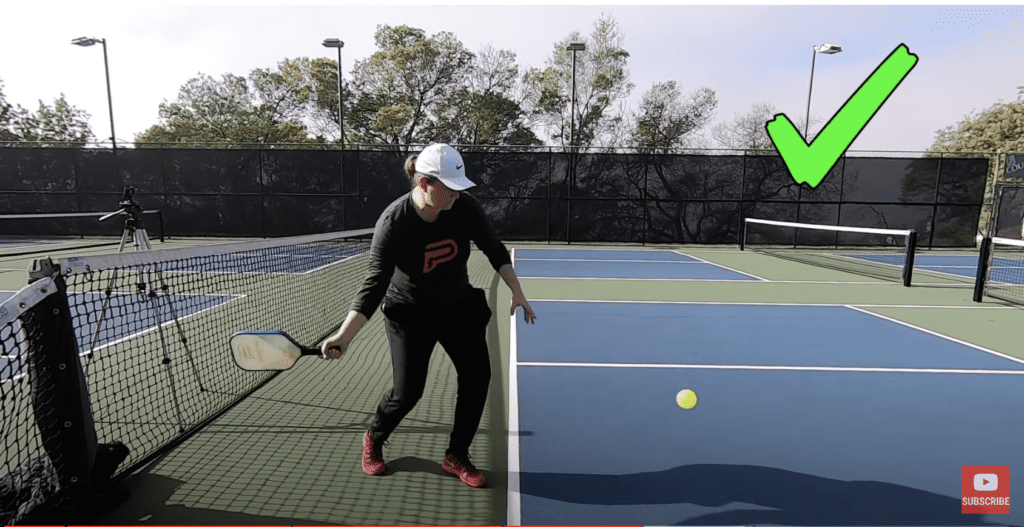In my opinion, the joy of pickleball is keeping the ball in play and rallying with your partners against your opponents. The longer you can keep the ball moving back and forth across the net, the more fun you will have. This is why I teach groundstrokes first. Sure, the serve is important – you can’t play a game without knowing how to serve – but of all the shots in pickleball, the groundstrokes are the ones you’ll be using most often. So let’s discuss how to hit groundstrokes – in this case, the forehand.
The first video that we’re going to look at for the forehand groundstroke comes from Barrett Kincheloe of The Pickleball Kitchen, called How to do a pickleball groundstroke for beginners. Kincheloe has many pickleball videos on YouTube, and I advise all my students to go to his website to read his articles and watch his videos.
In the picture below, you can see him in position just before hitting a forehand, with his paddle perpendicular to the ground and in front of his body. In this video, Barrett explains how to hit a forehand groundstroke and shows many examples of how to swing, how to get into position, and how to keep the ball on the court.

In this next video, called Groundstrokes with Sarah Ansboury, which dates back to 2016, you can see that Ansboury is basically in the same position before striking the ball as we saw in the previous video of Kincheloe. Ansboury is a fierce competitor on the professional pickleball circuit and a lead instructor for PPR (Professional Pickleball Registry), one of the organizations that certify pickleball instructors.
With the forehand groundstroke, notice how you shift your weight from the back to the front foot as you move the paddle from the ready position into the stroke. Notice too that your body is facing to the side so that you can swing through the ball and follow up with the paddle around ear-high on the opposite side. In order to keep a rally going, you must learn to master the forehand groundstroke.

Another well-known teaching pro, Jordan Briones, is featured on PrimeTimePickleball with a video on groundstrokes called Missing your Groundstrokes? Here’s why your groundstrokes may be inconsistent and lacking power. Similar to Sarah Ansboury, Briones shows how the dominant shoulder should be perpendicular to the net and the weight planted on the back foot. As you prepare to strike the ball, your shoulders open, and you want to be sure you strike the ball out in front of you. Just before you strike the ball, your weight shifts from your back foot to your front foot.

Briones cautions that because most of us only play doubles, we focus our attention on our net game and don’t practice our groundstrokes enough. Beginners must practice their groundstrokes if they want to become better pickleball players. According to Briones, “You’re dead in the water if you don’t have strong groundstrokes, because you have to start the point from the baseline and if you can’t be strong from back there, then you’ll never get up to the net.”
In this last video on the forehand groundstroke, The Forehand with Slow Motion, with Scott Moore, presented by PickleballChannel, you can see the perfect forehand in slow-motion. In the screenshot taken from the video, notice how far up towards the non-dominant shoulder Moore reaches to finish his forehand. All the pros use similar follow-throughs when hitting the forehand.

While watching Moore in slow-motion, you’ll see additional tips pop up on the screen that gives you more focused instruction on how to improve your forehand. According to Moore, “The forehand is one of those strokes that you use again and again in pickleball. Make yours a forehand you can count on!” Here are his tips to help you master the forehand:
- Make a full shoulder turn.
- Step in, shifting your weight to the front foot.
- Follow through strong above your shoulder.
- Watch the ball spinning on and off of your paddle.
- Swing up through the ball.
- Focus on your target to improve your accuracy.
- Let it rip!
This blog post is taken from Chapter 5, Learn the Pickleball Shots, in the revised edition of my first book, Pickleball for Beginners Part I. The chapter focuses on the various shots in pickleball: (1) Ground Strokes – forehand and backhand, (2) Serve, (3) Return of Serve, (4) Volley, (5) Dink, and (6) Overhead. I hope you get a chance to read my books. You can purchase a Kindle version or paperback on Amazon.
